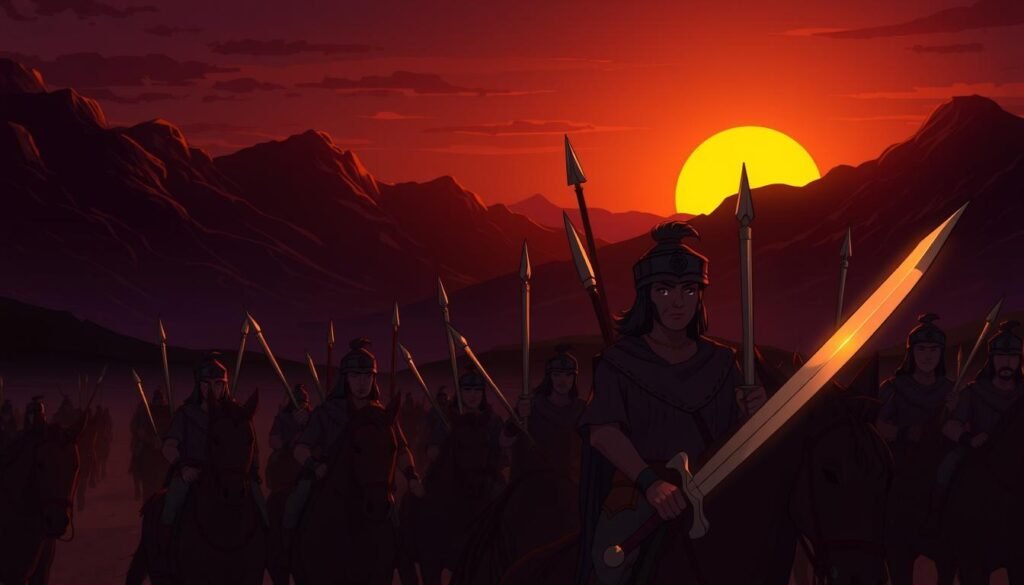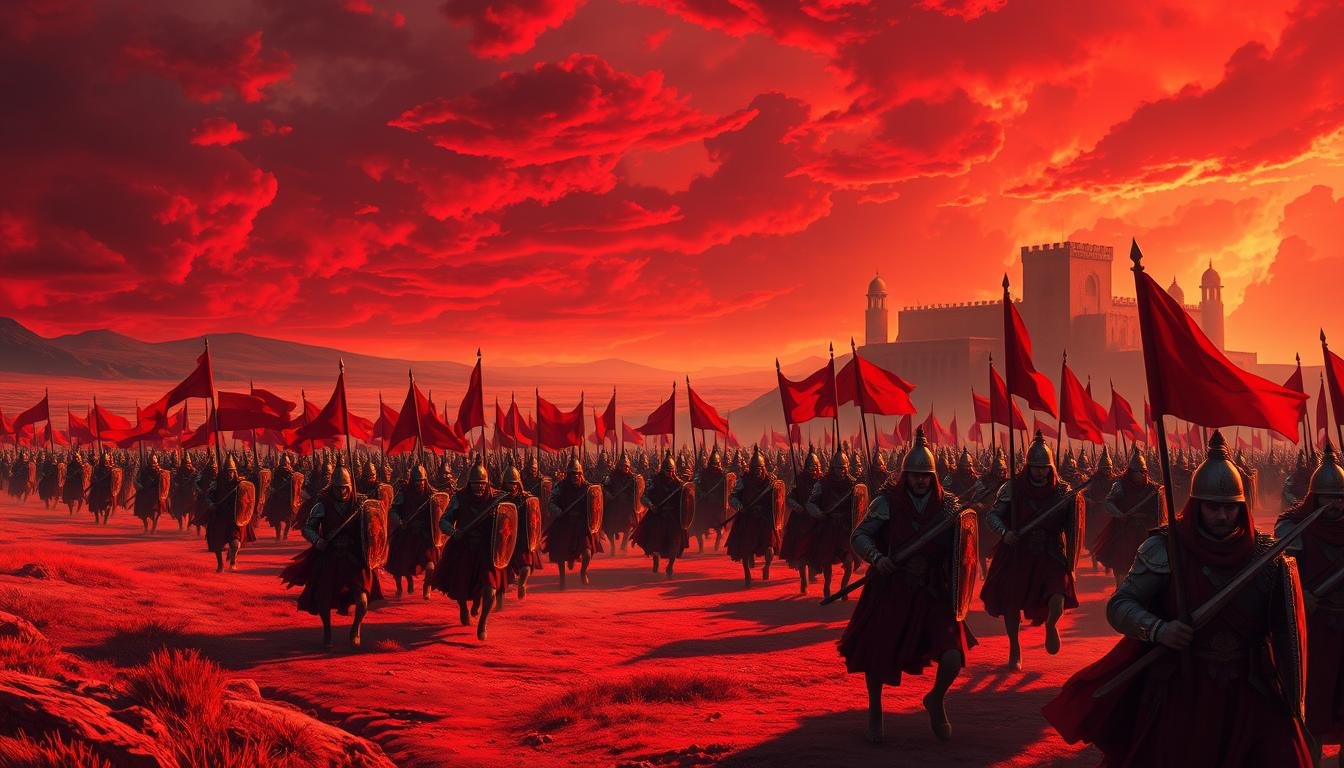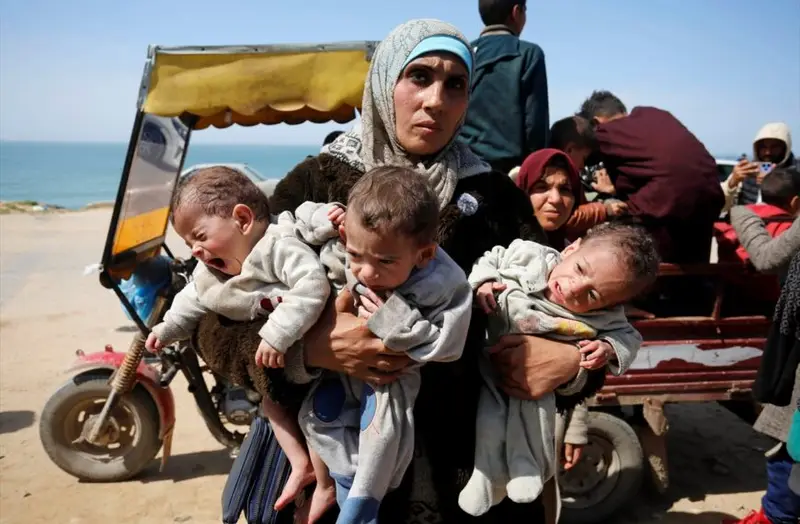Exploring the Ghazwa-e-Hind prophecy makes me think about Islamic eschatology. It shows how faith guides our actions. The idea that some will conquer India and others will be with Isa ibn Maryam (peace be upon him) is fascinating. It teaches us about the power of Islamic principles in our lives.
With about 200 million Muslims in India, the Ghazwa-e-Hind prophecy is key in Islamic eschatology. It mixes spiritual battle, justice, and divine help. Looking into this prophecy, we see its historical and geographical sides. We also see different views in Islamic studies, all helping us understand this big event.
Understanding the Concept of Ghazwa-e-Hind
The term Ghazwa-e-Hind breaks down into two parts: Ghazwa, meaning a military campaign, and Hind, which is the Indian subcontinent. To understand Ghazwa-e-Hind, we need to look at its roots and historical context. It’s also important to see its role in Islamic literature.
Exploring Ghazwa-e-Hind, we find many views and interpretations. Hadith interpretation is key to understanding its context. Muslim perspectives on this topic vary widely.
Etymology and Literal Meaning
The word “Ghazwa” comes from “ghaza,” meaning to aim for something or start a mission. In Islamic history, Ghazwa usually means battles led by the Holy Prophet. “Sariyya” refers to missions he didn’t lead.
Historical Context of the Term
The term “Ghazwa” has been used for military campaigns by the Prophet Muhammad and his followers. But Ghazwa-e-Hind is more complex. It has been seen as both a military conquest and a peaceful spread of Islam.
Significance in Islamic Literature
The meaning of Ghazwa-e-Hind in Islamic texts is debated. Some see it as a military victory, while others view it as a spiritual or intellectual battle. As we dive into Ghazwa-e-Hind, we must look at all the views and interpretations. This includes Hadith interpretation and Muslim perspectives on this complex topic.
The Origins and Authentication of Hadith about Ghazwa e Hind
Exploring Ghazwa-e-Hind prophecy means looking into its origins and the truth of Hadiths about it. “Ghazwa-e-Hind” talks about Islamic forces conquering Hindustan. This idea is key in Islamic eschatology. It’s interesting to see how people interpret this prophecy today.
Checking if Hadiths are true is very important. Islamic scholars have looked closely at these stories. They found out what Ghazwa-e-Hind might mean for us now.

The Quran says we shouldn’t fight for our faith. This means Ghazwa-e-Hind can’t be about violence. Looking into history, we see Ghazwa-e-Hind is more about a spiritual fight than war.
Key Sources and Narrations of the Prophecy
Exploring Ghazwa-e-Hind, we must look at the main sources and stories. These stories are key to understanding what Muslims think about Ghazwa-e-Hind. It’s important to check the story’s chain to see if it’s true.
The most talked-about story is: “Two groups of my ummah Allah has protected from the Hellfire: a group that will conquer India and a group that will be with Isa ibn Maryam (peace be upon him).” (Sunan al-Nasa’i) This story shows how important Ghazwa-e-Hind is in Islamic texts. It also hints at big changes for Muslims. I’ll look into different Hadith collections, like the Sunan al-Nasa’i, to understand the prophecy better.
Primary Hadith Collections
The main Hadith collections, like the Sunan al-Nasa’i, give us important insights. They help us see the prophecy’s meaning and its role in Muslim views.
Chain of Narration Analysis
It’s important to study the story’s chain to make sure it’s real. By looking at the chain, we can understand the story’s trustworthiness and its meaning.
Scholarly Validations
Experts’ opinions are key to confirming the Hadith’s truth. Their views help us see the prophecy’s importance. This adds to our understanding of Hadith interpretation.
Historical Context During the Prophecy’s Revelation
The history of Islam in the Indian subcontinent is very interesting. Early Muslim expeditions, like Muhammad bin Qasim’s conquest of Sindh in 711 CE, started Muslim rule. This event is key to understanding the Islamic eschatology of the Ghazwa-e-Hind prophecy.
The region of Hind has always been important to Islamic scholars and rulers. The Ghazwa-e-Hind prophecy is seen in many ways. Some think it’s a call to jihad against non-Muslims. But, we must understand the history and different views within Islam.

In conclusion, the history of the Ghazwa-e-Hind prophecy is complex and rich. By looking at early Muslim expeditions and different views on the prophecy, we learn more. This helps us understand the Ghazwa-e-Hind prophecy and its role in Islamic eschatology.
Different Interpretations Among Islamic Scholars
Exploring the Ghazwa-e-Hind prophecy, I see how Hadith interpretation is key. Views on Ghazwa-e-Hind among Muslims vary widely. Some think it’s about real battles in India, while others see it as a call to inner struggle.
Scholars debate the Ghazwa-e-Hind’s meaning, with some saying it misinterprets the Prophet’s words. The book “What Is The Reality Of Ghazwa-E-Hind” dives deep into this topic. It shows the need for correct Hadith interpretation and understanding of Muslim perspectives on Ghazwa-e-Hind.
Looking at all views, we see Ghazwa-e-Hind is a complex idea.
As Maulana Mufti Salman Mansoorpuri notes, the chain of narrators is weak and confusing, leading to varying interpretations of the prophecy.
By looking at these views, we can better understand the Ghazwa-e-Hind prophecy. It helps us see its role in Islamic thought.
Geographical Implications in the Prophecy
The Ghazwa-e-Hind prophecy has big implications for geography. It talks about different places and areas. This prophecy is tied to Islamic tradition and is very important.
It is often linked to the Indian subcontinent. This includes Pakistan, India, and Bangladesh.
The Islamic eschatology around Ghazwa-e-Hind is complex. Scholars and groups have different views. Some think it’s about a certain area, while others see it as a wider idea.
Groups like Al-Qaeda and ISIS have used it to support their actions. They see it as a reason to fight in the region.
Looking into the Ghazwa-e-Hind prophecy shows it’s not just about one place. It’s a deep and changing idea. It has been used to start wars and attract fighters. This shows we need to understand it well in Islamic eschatology.
Timeline Debates and Prophetic Signs
Exploring Ghazwa-e-Hind, we look at timeline debates and prophetic signs. The prophecy of Ghazwa-e-Hind, found in Hadith interpretation, says the battle in India is coming. This has led to many discussions among Muslim scholars.
Some believe the prophecy is happening now. Others think it’s yet to come. The story of Ghazwa-e-Hind is linked to a fatwa from Darul Uloom Deobandum. It says Islamic forces will attack India.
Dr. Hafeezur Rahman says Hadith teachings must be very true. He believes predicting future Ghazwa wars is not logical. This is because Prophet Muhammad (PBUH) is not alive.
Historical Ghazwa wars, like Ghazwa Khandaq and Ghazwa tabuk, were peaceful.
Recently, Hadith interpretations about Ghazwa-e-Hind have been used wrongly. They were used to justify violence in Kashmir. Most Islamic scholars in Pakistan say Ghazwa-e-Hind is against Islam.
The Quran talks about Islamic dominance in a spiritual and ideological sense. It’s not about politics (Chapter 61, Verse 9). When we look at Muslim views on Ghazwa-e-Hind, we must check the Hadiths’ truth. We must also see if they match the Quran’s teachings.
Modern Academic Perspectives on the Prophecy
The idea of Ghazwa-e-Hind sparks a lot of debate among Islamic scholars today. Some see it as a call to fight for what’s right. Others think it’s about a future war. The real value of this Islamic eschatology is how it shapes today’s Islamic views and actions.
Experts say we must understand Ghazwa-e-Hind in its historical and cultural setting. They stress the importance of looking beyond sensational or political views. They want us to see it as a call for justice, goodness, and helping others, not as a reason for violence.
Some researchers also link Ghazwa-e-Hind to “Jihad al-Akbar,” or the “Greater Jihad.” This idea focuses on fighting one’s own bad desires. They think Ghazwa-e-Hind might be seen as a symbolic fight, not a real war.
FAQ
What is the concept of Ghazwa-e-Hind in Islamic eschatology?
What is the etymology and literal meaning of the term "Ghazwa-e-Hind"?
What are the key sources and narrations of the Ghazwa-e-Hind prophecy?
How have Islamic scholars interpreted the Ghazwa-e-Hind prophecy over time?
What are the geographical implications of the Ghazwa-e-Hind prophecy?
What are the timeline debates and associated prophetic signs related to the Ghazwa-e-Hind prophecy?
How do modern academics view and interpret the Ghazwa-e-Hind prophecy?

Embracing Faith, One Insight at a Time!
The teachings of the Quran have always guided my path. With a deep passion for Islamic knowledge, I strive to blend the wisdom of tradition with the relevance of today, making the timeless messages of Islam accessible and meaningful for everyone.
Muslim Culture Hub is my platform to share historical insights and thought-provoking articles, exploring both well-known and lesser-discussed aspects of Islamic culture and beliefs. My mission is to create an inclusive online space where everyone can learn, strengthen their faith, and connect with the profound message of Islam.
Join the journey!
May peace be upon you.










